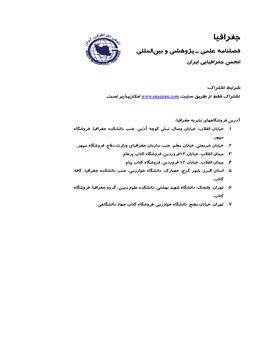The Evaluating of Spatial Distribution of Population and Services in Urban Zones of Tabriz
Subject Areas :Rahim Sarvar 1 , 2 , 3
1 -
2 -
3 -
Keywords: Population Distribution, Distribution Services, , Entropy Index, TOPSIS,
Abstract :
Today one of the most important issues in urban planning, discussion of balanced and proportionate development in cities having a population of urban services is appropriate. The urban planners to collect and analyze local and spatial data and reflect the results to urban managers are trying in achieving this goal is the distribution of urban facilities and services will lead to a way that will benefit all social groups in society and lead to social and spatial justice in cities. This study aimed to investigate the relationship between population distribution and the distribution of urban services in urban regions, 37 urban regions of Tabriz and evaluation its urban areas and its population; the civil service has been made. In this study, to assess the distribution of population of the relative entropy model and to assess distribution of services have been used TOPSIS model. The method of this study is descriptive-analytical. The results of entropy model indicates that the distribution of population is proportionate in Tabriz; Also, the evaluation results the distribution of urban services in urban regions indicate that regions of zone 9,10 Tabriz which have the lowest utility and region 1 of zone 2 and zone 3 in the TOPSIS model are having the greatest enjoyment of civil service. Also, the evaluation results correlation between population rank and to its impact on the enjoyment of civil service pay, by using of the Spearman model about (0.4991) shows a high correlation between population rank and access to urban services exist.
1. بوچانی، محمدحسین (1385)، «بررسی عدم تعادلهای فضایی ـ اجتماعی شهر ایلام از دیدگاه توسعه پایدار»، مجله شهرداریها، سال ششم، شماره 73؛
2. حکمت¬نیا، حسن و موسوی، میرنجف (1385)، کاربرد مدل در برنامه¬ریزی شهری و ناحیهای، انتشارات علم نوین، چاپ اول، یزد؛
3. خوش¬روی، قهرمان (1385)، «عدالت اجتماعی و فضایی شهر»، اولین همایش ملی عمران شهری، دانشگاه آزاد اسلامی واحد سنندج، (www.civilica.com)؛
4. ذاکریان، ملیحه؛ موسوی، میرنجف؛ باقری¬کشکولی، علی (1389)، تحليلي بر پراكنش جمعيت و توزيع خدمات در محلات شهري ميبد از منظر توسعه پايدار، مجله پژوهش و برنامه¬ریزی شهری، سال اول، شماره دوم؛
5. زياري، کرامت¬الله (1383)، اصول و روشهای برنامه¬ريزي منطقهای؛ چاپ سوم، يزد: انتشارات دانشگاه يزد؛
6. صادق¬زاده، محمد (1389)، ساماندهي فضايي- كالبدي شهر ماكو با تأكيد بر كاربري اراضي شهري، پایان¬نامه کارشناسی ارشد، دانشکده علوم انسانی و اجتماعی، دانشگاه اصفهان؛
7. عبدی دانشپور، زهره (1378)، «تحلیل عدم تعادل فضایی در شهرها، مورد تهران»، مجله صفه، سال نهم، شماره بیست و نهم؛
8. هادی¬پور، حلیمه¬خاتون؛ فرهودی، رحمت¬الله و احمد پوراحمد (1385)، «معیارهای مؤثر در مرزبندی نواحی مناطق شهری (منطقه یک شهرداری تهران)»، فصلنامه پژوهشهای جغرافیایی؛
9. هاروي، ديويد (1379)، عدالت اجتماعي و شهر، مترجم: فرخ حساميان و ديگران، تهران: شركت پردازش و برنامه¬ريزي شهري؛
10. ساوج، مایک و آلن وارد (1380)، جامعه¬شناسی شهری، ترجمهی ابولقاسم پوررضا، تهران:انتشارات سمت؛
11. M.-T. Chu & et al (2006), Comparison among Three Analytical Methods for Knowledge Communities’ Group-decision Analysis, Expert Systems with Applications xxx (2006) xxx–xxx;
12. S. Opricovic, G.-H. Tzeng (2004), Compromise Solution by MCDM Methods: A Comparative Analysis of VIKOR and TOPSIS, European Journal of Operational Research, Vol. 156;
13. Tsai, yu. Hsin (2005), Quantifying Urban form Compactness Versus Sprawl, Urban Studies, Vol. 142, No. 1;
14. M artinez,J,(2009),The use of GIS and indicators to monitor intra-urban inequalities a case Rosario.argentina,habitat international,vol.33,no,1.Pp.387;
15. Dixon J.and ramutsindela,M.(2006),Urban resettlement and environmental justice in cape town,cities,23(2),129-139.


